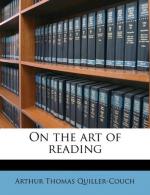IX
Yet, and when this has been granted, the crucial question abides and I must not shirk it ’you say that the highest literature deals with What Is rather than with What Knows. It is all very fine to assure us that testing our knowledge about Literature and around Literature, and on this side or that side of Literature, is healthy for us in some oblique way: but can you examiners examine, or can you not, on Literature in what you call its own and proper category of What Is?’
So I hear the question—the question which beats and has beaten, over and over again, good men trying to construct Schools of English in our Universities.
With all sense of a responsibility, of a difficulty, that has lain on my mind for these five years, I answer, Gentlemen, ’Yes, we ought: yes, we can: and yes, we will.’
But, for the achievement, we teachers must first know how to teach. When that is learned, Examination will come as a consequent, easy, almost trivial matter. I will, for example— having already allowed how hard it is to examine on literature —take the difficulty at its very extreme. I will select a piece of poetry, and the poet shall be Keats—on whom, if on any one, is felt the temptation to write gush and loose aesthetic chatter. A pupil comes to read with me, and I open at the famous “Ode to a Grecian Urn.”
(1) We read it through together, perhaps twice; at the second attempt getting the emphasis right, and some, at any rate, of the modulations of voice. So we reach a working idea of the Ode and what Keats meant it to be.
(2) We then compare it with his other Odes, and observe that it is (a) regular in stanza form, (b) in spite of its outburst in the 3rd stanza—’More happy love! more happy, happy love’ etc.— much severer in tone than, e.g., the “Ode to a Nightingale” or the “Ode to Psyche,” (c) that the emotion is not luscious, but simple, (d) that this simplicity is Hellenic, so far as Keats can compass it, and (e) eminently well-suited to its subject, which is a carven urn, gracious but severe of outline; a moment of joy caught by the sculptor and arrested, for time to perpetuate; yet —and this is the point of the Ode—conveying a sense that innocent gaiety is not only its own excuse, but of human things one of the few eternal—and eternal just because it is joyous and fleeting.




